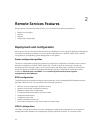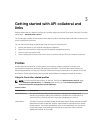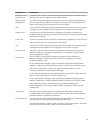
Out-of-band server performance monitoring
Using this feature, you can monitor the performance index of CPU, memory, and I/O. Intel ME supports
Compute Usage Per Second (CUPS) functionality for monitoring the performance. The monitoring is
independent of the OS and does not use CPU resources. The Intel ME displays a platform CUPS sensor
that provides the Computation, Memory and I/O resource utilization value in the form of a platform
“CUPS Index”. iDRAC monitors this CUPS index for overall system utilization and also the instant value of
CPU, Memory, and I/O utilization index.
NOTE: To use this feature, iDRAC enterprise license is required.
For more information about monitoring the out-of-band performance, see the Base Metrics and Sensors
profile document available at en.community.dell.com/techcenter/systems-management/w/wiki/
1906.dcim-library-profile.aspx.
Maintain
Using various Lifecycle Controller-Remote Services capabilities, you can maintain the health of a system
throughout its lifecycle. You can use features such as remote firmware management, part replacement,
server profile import or export, and auto-discovery to maintain a system using Lifecycle Controller-
Remote Services.
Server configuration profiles — export or import
Lifecycle Controller-Remote Services can export or import a Server Configuration Profiles file. The export
operation collects the configuration information for BIOS, iDRAC, RAID, NIC, FC-HBA, System, and
Lifecycle Controller and stores it in a single file that is copied to a network share. The Import operation
imports the file from a network share, and applies the previously saved or updated configurations
contained in the file to a system. For more information, see Server Cloning with Server Configuration
Profiles and Creating and Managing Server Configuration Profiles documents available at
en.community.dell.com/techcenter/systems-management/w/wiki/1906.aspx.
Firmware update
You can perform firmware updates from a network source to either update or rollback component
firmware. A rollback operation is used to install the previous version of a component firmware. It also
provides the ability to update using a repository and schedule automatic updates.
The firmware update operations or firmware rollback operations are performed in the following order:
1. Initiate and download an image.
2. Create a reboot job.
3. Schedule an update job.
4. Monitor a job until the job is finished.
NOTE: The immediate updates such as diagnostics, driver pack, Lifecycle Controller, and iDRAC are
not required to be scheduled. These update processes move from downloading state to completed
state. Whereas, iDRAC updates reset the iDRAC when the job is marked completed.
19


















